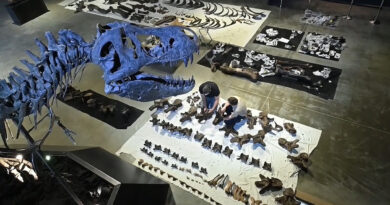Largest Golden Mask Ever After 3,000 Year Old Artefact Unearthed In Ancient Chinese Sacrifice Pit
This intact 3,000-year-old golden mask has been unearthed from an ancient sacrifice pit and measuring nearly 40 centimetres wide, it could be the largest golden mask and the heaviest gold object from the period ever found in China.
The golden mask was unearthed at the Sanxingdui Ruins archaeological dig near the township of Nanxing Township in the Chinese province of Sichuan Province.
Back in March they had already found an incomplete golden mask at the same site and the leader of that archaeological excavation, Lei Yu, had said at the time: “According to the half of the mask found so far, it is speculated that the complete weight of this golden mask should exceed 500 grammes (1.1 lbs).”

Lei Yu had also said that if a complete mask were to be found, it would be the largest golden mask and the heaviest gold object from the period found in China.
Now this intact gold mask, measuring 16.5 centimetres (6.5 inches) in height and 37.2 centimetres (14.6 inches) in width, was unearthed at Pit No.3 at the archaeological site, according to the country’s National Cultural Heritage Administration. It is similar in size and there is a resemblance with facial features on a bronze head that was also unearthed at the ruins.
The head of the Sanxingdui Institute of Archaeology, Ran Hongling, said: “We speculate that this golden mask was a part of the face of the bronze head instead of a separate object.”

The fragmented golden mask found in March was reportedly believed to be from the Shang (1600 BC – 1046 BC) and Zhou (2070 BC – 600 BC) dynasties in what was then the Kingdom of Shu, one of the three major states that would later compete for supremacy over all of China in the Three Kingdoms period (220 AD to 280 AD).
The mask fragment was found in the fifth pit of the six pits excavated in the area. It is about 23 centimetres (9 inches) wide, 28 centimetres (11 inches) high and weighs 280 grammes (0,6 lbs).
The golden artefacts were a symbol of power and used in ceremonies of worship by the ancient Shu people.

In March, when they had also uncovered a significant haul of 500 other artefacts, Lei Yu had also said: “This golden mask was also used for sacrifices, but because it is much larger than a human face, it is unlikely that it was worn by a person.
“It demonstrates the worship of gold in the ancient Shu civilisation, and it also carries a lot of mysterious information waiting to be uncovered.”
In this latest dig, archaeologists also found a large bronze mask, bronze statues and ivory carvings. The large bronze mask is 74 centimetres in height and 135 centimetres in width and was found at Pit No.3, also making it the largest bronze mask found at the historical site to date.

Meanwhile, three similar statues made of bronze were unearthed at Pit No.4, offering an important insight into the social structure and religion of the Shu Han Kingdom, one of three kingdoms in the region at the time.
Chinese archaeologists said the fourth pit dates back to between 2,966 and 3,148 years ago during the Shang Dynasty (1600 BC to 1046 BC), according to the Sichuan Provincial Cultural Relics and Archaeology Research Institute.
Experts found a bronze statue with an unusual hairstyle and a kneeling bronze figure with its head facing to the right and its hands resting on the left side of the body.

According to the archaeologists, 729 artefacts have been unearthed at Pit No.3 while 1,073 have been found at the fourth pit, including three items made of as-yet-unknown materials.
Meanwhile, 200 ivory pieces have been discovered at the eighth pit with scientists expecting to extract all the artefacts in this pit by October.
The Sanxingdui Ruins dig site covers an area of about 12 square kilometres (4.6 square miles) and was discovered in the late 1920s. Six new sacrifice pits were discovered between November 2019 and May 2020.



